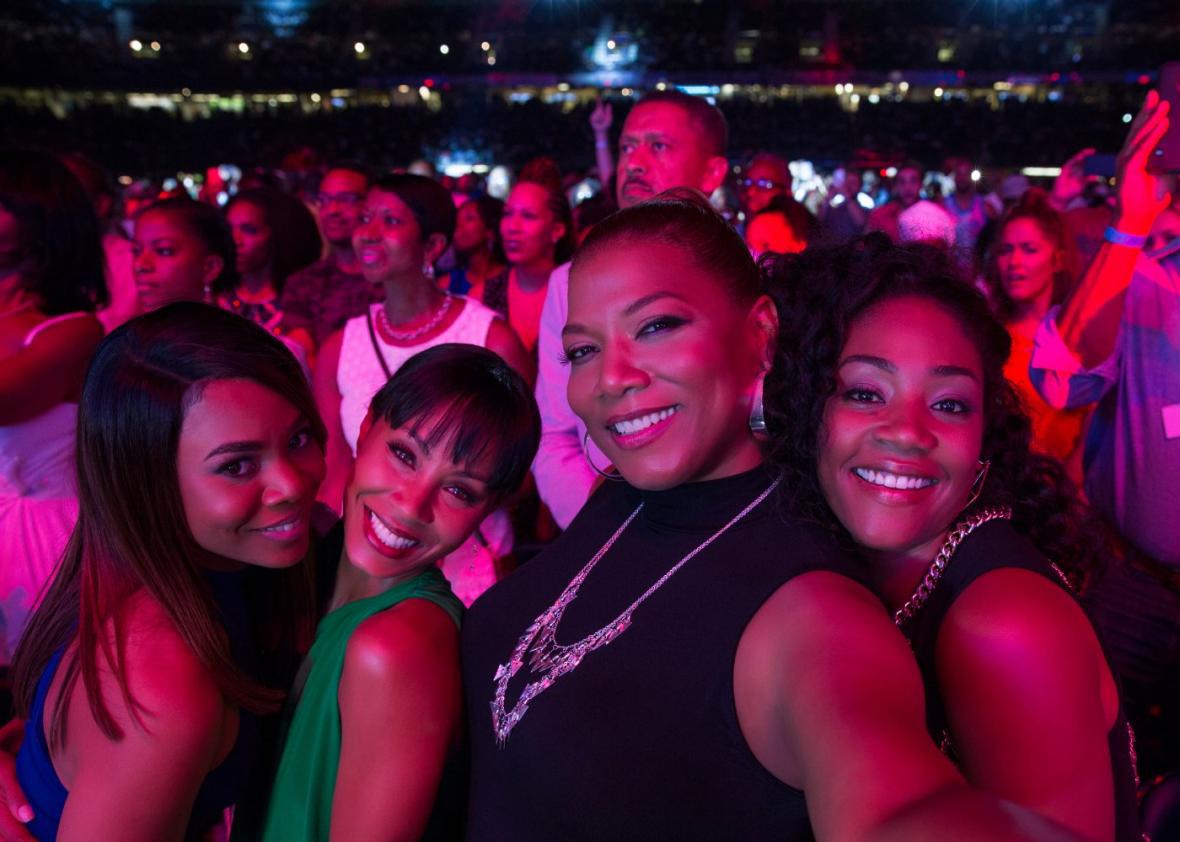This past weekend was a great one at the box office for new, nonfranchise releases—well, some of them, anyway. Christopher Nolan’s stunningly shot World War II epic Dunkirk debuted on top with an unexpected $50.5 million, while Malcolm D. Lee’s R-rated comedy romp Girls Trip came in second place, with $30.4 million. Girls Trip especially overperformed: It only cost $19 million to make; received a rare A+ Cinemascore—data from a market research firm that polls major movie releases on opening night (for comparison, even the tears of joy–inducing Wonder Woman only scored an A)—and became the highest-grossing live-action comedy of the year so far, following a string of R-rated summer comedies that failed to land with audiences.
It’s already way past time to cease being “surprised” by the box office success of low- to moderately budgeted movies targeted at black American audiences. Over the past few years, several movies ranging from comedies to thrillers to dramas have proven that established black actors, strong stories, and perhap, most importantly, enthusiastic word of mouth, can do wonders for such films being seen by large audiences. The well-reviewed Girls Trip is no different. With beloved stars who understand the power of social media (Queen Latifah, Jada Pinkett Smith, and Regina Hall), an established director with no shortage of credit within the black community (Lee helmed both Best Man films and the underrated satire Undercover Brother), and a breakout star, Tiffany Haddish, whose uproarious performance makes others want to see what all the fuss is about, the comedy was basically a slam dunk in the midst of this summer’s fare.
The cultural benefits of the movie’s success are obvious—as with Hidden Figures earlier this year, black women have been lucky enough to see themselves portrayed in a different light than what they are used to on screen, and this will hopefully encourage studios to continue thinking outside the box when greenlighting movies about people of color. But just as encouraging is what Girls Trip demonstrates for its leading ladies, who range in age from 37–47 and are at varied points in their careers. In the cases of Pinkett Smith and Hall, their filmographies boast impressive works—Pinkett Smith made a name for herself first in the later years of Cosby Show spinoff A Different World, as well as Menace II Society, Set It Off, and The Matrix sequels; Hall broke through in the Best Man, Scary Movie, and Think Like a Man franchises. Still, there’s no denying that when compared with white peers like Jennifer Aniston and Reese Witherspoon, they haven’t been afforded the same opportunities for meaty, three-dimensional roles—or the other benefits that often come with being a movie star, such as hosting Saturday Night Live. (“I’m not a new face, but to some people, I am,” Hall once observed about her career.) Queen Latifah has had arguably the biggest career of the Girls Trip ladies, having hosted SNL (2004), been nominated for an Oscar (for Chicago), and previously opened a No. 1 comedy sold in large part on her star power (Bringing Down the House). (That’s not to mention her early beginnings as a rapper and star of a hit ’90s sitcom.) Still, it’s been a while since she’s had a hit of this nature, and this proves she’s still a star.
Girls Trip serves as a corrective for these three stars, especially Hall, whose character Ryan anchors the main storyline and who gets to have the movie’s climactic epiphany as well as its climactic speech. It does for them what Hidden Figures did for Taraji P. Henson and Octavia Spencer, giving them roles that were long overdue for actors of their caliber and experience while putting them, and not their white co-stars, front and center. And because of the excellent reviews and its placement as summer counterprogramming to big-budget franchises, its crossover success—white audiences made up 38 percent of ticket buyers, according to one industry metric—may help open doors for them that weren’t previously available before.
Haddish is the youngest of the bunch, and until now was the least known, but she undoubtedly stands to gain the most, garnering rave reviews for her performance across the board, charming audiences with stories about how out of touch with “normal” people Will and Jada are and an upcoming stand-up special that is sure to get a lot of eyeballs in the wake of Girls Trip. At 37, she’s having a late career breakthrough, but whereas 20 years ago or so that wouldn’t have necessarily translated into more and/or even greater opportunities—just look at the early careers of Angela Bassett and Viola Davis, who have been at this for decades and are only recently getting consistent, quality high-profile on-screen work—it seems like she could easily parlay this into a budding career on par with Melissa McCarthy’s or Amy Schumer’s.
It’s not that any of these women have lacked the talent or even the film reel highlights to be bigger stars than they are—black audiences have recognized and celebrated them long before nonblack ones did and will continue to do so, even if Hollywood does wind up failing on the uptake. But maybe it’s the big wins such films have seen recently, both in box office and in awards attention, that makes it seem more likely than ever before that Girls Trip will be more than a blip on the radar. Something about it and the climate it currently inhabits seem different—and it’s not (entirely) the grapefruit.
